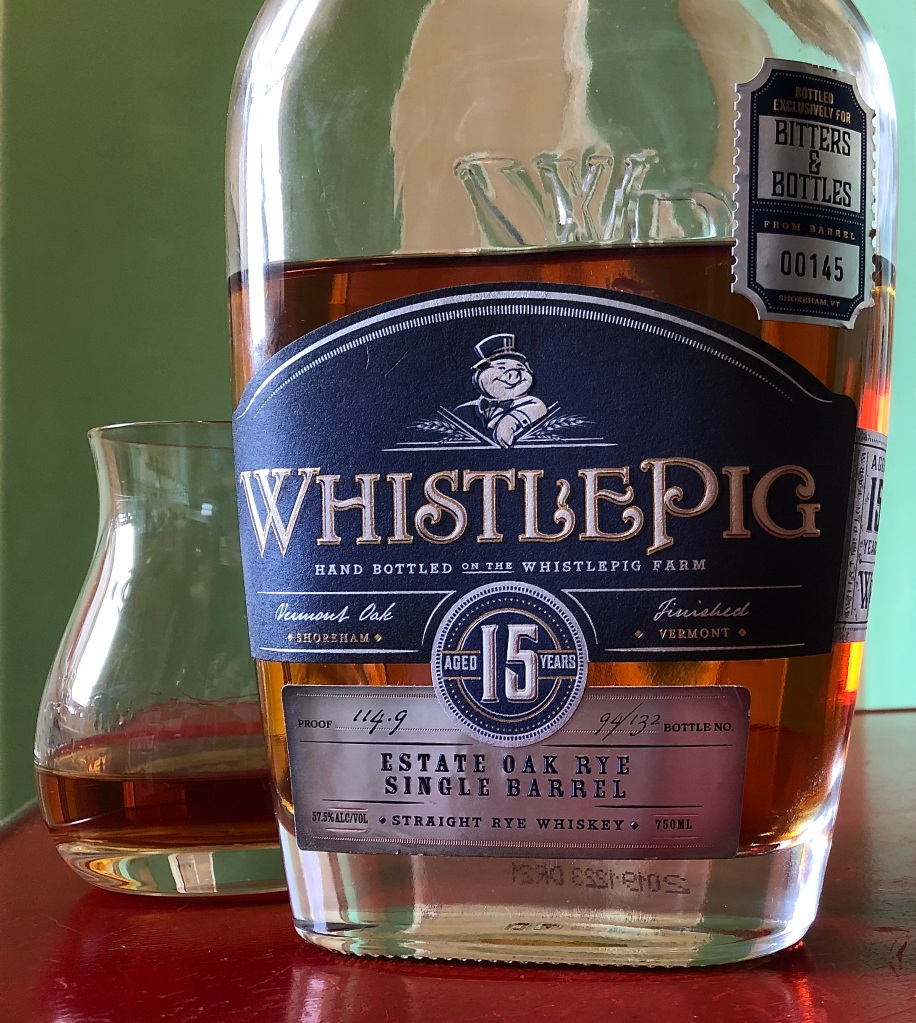WHISTLEPIG 15 YEAR RYE
Single Barrel 00145 selected by Bitters & Bottles (2020)MASH BILL – undisclosed Canadian rye
PROOF – 114.9
AGE – 15 years
DISTILLERY – Bottled by WhistlePig in Vermont, sourced from Canada
PRICE – $230
BUY AGAIN? – No, because $$$ and one particular flavor note…

I’ve been a big WhistlePig fan ever since I first tried their standard 10 Year release at a bar in Portland, Oregon, back in 2016. I was intrigued by this little Vermont farm sourcing Canadian ryes—an area of whisky I was actively exploring at that time. The 10 Year gets finished in bourbon barrels, which adds a layer of caramel to the rye that just hits all the right marks for me.
Then in 2017, the California warehouse chain, K&L, came out with four single barrels of the 10 Year. Together they comprised a kind of swan song pick for the K&L spirits buyer at the time, David Driscoll, who wrote them up with a certain amount of gratitude for being able to move on from K&L with such a clutch of great whiskeys among his final acts. I bought all four and am still making my way through them. So far, each has been exceptional.
So you can imagine the anticipation with which I looked forward to uncorking this single barrel of a WhistlePig rye with a full 15 years under its belt. It’s stumped me. I’ll explain why. Here first are some brief notes, taken a week after uncorking and a good full handful of pours into this bottle, and tasted in a Canadian Glencairn considering the origins of the distillate.
COLOR – rich vibrant orange heading toward copper, with yellow highlights
NOSE – bright and floral rye spices, lemon zest, some white pepper, dry hay bails, caramel wafting in the background, a faint and fleeting rubbery note
TASTE – floral rye spice, bright caramel, and that rubber note, all at once and all on equal footing
FINISH – same flavors, and now also some nice chocolate fudge in the mix, and something like a mixed nut butter
OVERALL – if it weren’t for that rubber note…
Rubber is a flavor note I just can’t abide. I was so disappointed to find it so prominent at uncorking. Sampling the whiskey over the course of a week, in various glasses, at various times both pre and post dinner, that rubber note has not budged.
It immediately took me back to three rye whiskeys, all 100% Canadian rye mash bills sourced and bottled by R.J. Cooper & Son in Philadelphia, PA—Hochstadter’s Family Reserve 16 Year, Lock Stock & Barrel 16 Year, and Lock Stock & Barrel 18 Year. They all featured this rubbery note, and I eventually traded each bottle away for other things.
So when this similarly aged WhistlePig featured that note, I started asking around my whiskey circles. Some people who had also tried this same Bitters & Bottles single barrel said they did not taste the rubber aspect. Others did. One Facebook friend shared some intel:

I looked up “creosole,” actually spelled “creosol.” It’s an oily liquid found in beechwood tar, from beech trees, and guaiac resin, from a tree species Guaiacum officinale. It’s also an active component of the more readily identified “creosote,” itself a compound of carbon chemicals found in tars and fossil fuels—and rye grain. It is sometimes used in preservatives and antiseptics.
Another fellow whiskey fan, with whom I shared a sample of this bottle, put it this way:

I think “a hint of driving with the emergency break on” is now my favorite whiskey note ever. Nevertheless, whether one calls it “rubbery,” “creosote,” or “emergency break,” it’s not appetizing.
But as I said, some people don’t interpret this flavor note as rubber, something the first Facebook friend above corroborates when he offers “freshly polished leather” as an alternative interpretation.
But for me it’s rubber. The other primary flavors in this WhistlePig 15 Year—spicy floral rye and lemony caramel—are strong enough that the rubber note is here the least off-putting of the now four whiskeys in which I’ve experienced it. To my surprise I find myself able to get past it and to somewhat enjoy the whiskey. But at this price range I don’t want to merely somewhat enjoy a whiskey.

Well-aged American ryes have not presented with this interpretable rubber note. So what this bottle might confirm is that whatever is happening in Canadian rye after 10 years of aging is simply not for me. My stubbornness makes me want to compare this single barrel with a standard release of the 15 Year. But the risk isn’t worth the cost. Maybe a friend will come along with a sample. 😉
I’ll likely offer this up to my partner for cocktails. She has “champagne tastes” when it comes to whiskey—even though she does not prefer whiskey neat—and has repeatedly asked if she could mix this WhistlePig 15 Year with her favorite ginger-lemon kombucha. I’ve declined until now. But if she enjoys it mixed with kombucha more than I enjoy it served neat, then it will be put to better use with her than with me.
This has been a curious experience. And I remain curious. Even as I type up these notes and continue sipping at my glass, the rubber note very gradually ebbs in favor of the caramel and spice notes. Hmm…
If you have thoughts about this rubber note in well-aged Canadian rye whiskeys, please do share them in the comments below.
Cheers!








